Crimsoness is the English-language translation of a 2007 freeware Japanese visual novel called Shakunetsu Hime. The original Japanese visual novel was created by a developer who them went by Porn, but subsequently went by Pawn, and released for Windows on April 2, 2007. After receiving permission from Porn (or Pawn), Insani, a Mr. Edward Keyes of the visual novel translation circle Insani, working under the supervision of Mr. Seung Park, translated Shakunetsu Hime as Crimsoness and submitted it to the 2008 al|together translation festival. I am working on a project to review nearly all of the nearly-30 freeware Japanese visual novels translated into English for the 2005, 2006, and 2008 al|together festivals. Crimsoness, which I review here, is my 19th review of the project.

(To learn more about the project, see my al|together introduction, completed reviews list, and collection hub for al|together articles.)
Crimsoness is a unique al|together entry. The player takes the role of a young lady (high school student) named Bakumi Moriyama. She reached her limit after messing up on a test, and so set off on a mission to destroy the world. Crimsoness is the only timed al|together visual novel – the player has 3 minutes to destroy the world. The time limit is accompanied by a rage meter, which is tied to whether Bakumi will succeed in her goal of destroying the planet because her own mistake was caused by global (or perhaps universal) corruption. The entire game is drawn in red – reminding one of the red pen which would surely mark all of Bakumi’s test answers wrong after she misjudged the answer boxes. It is simultaneously easy to summarize and impossible to explain. Without further ado, let us begin the review.
Crimsoness Details
English version
| Title | Crimsoness |
| Translator | Edward Keyes & Seung Park (Insani) |
| Release Date | November 28, 2008 |
| Scripting Language | Delphi |
| Official Websites | altogether 2008 |
| Visual Novel Database | VNDB Entry |
Insani published several essays on Crimsoness, all of which we will refer to in the review.
- About the Japanese developer
- Essay by translator Edward Keyes
- Peer review by supervising translator Seung Park
- Analysis by Seung Park
These essays and retrospectives are all from the official al|together 2008 page for Crimsoness.
Japanese original
| Title | Shakunetsu Hime |
| Developer | Porn (Pawn) |
| Original Release | March 3, 2007 (V1.00); April 2, 2007 (V1.01) |
| Scripting Language | Delphi |
| Official Website | Still live |
Running and Installing Crimsoness
Crimsoness is a unique al|together entry in many respects. The vast majority of the Japanese games translated for al|together were written in a visual novel scripting language called NScripter. The English versions were written in the open source ONScripter-EN, which is still being developed (all of the al|together 2008 entries, exempting Crimsoness, are ONScripter-EN). A minority of the 2005 and 2006 entries were written in an open source visual novel scripting engine called KiriKiri (see 2005 and 2006 examples). From my perspective running these games on Linux, the ONScripter-EN set is convenient since they are easy to run naively on Linux.
Unlike its al|together siblings, Crimsoness is written in the Delphi programming language. I know nothing about Delphi, but we will discuss Insani’s thoughts on working with the script and programming to make Crimsoness presentable in English. The al|together 2008 website only offers an English-language download of Crimsoness for Windows. I first ran Crimsoness on Windows Visa and 7 a long time ago with no issues. For this review, I ran Crimsoness under WINE on Linux and again had no issues, technical or otherwise. Crimsoness is available as a direct download from Insani’s al|together 2008 website.
Prefatory Crimsoness age rating opinion
Most of the al|together visual novels I have reviewed are perfectly fine reading for all ages (not that I would expect most kids to sit and read through Red Shift, May Sky, or Flood of Tears). While Crimsoness is far from an adult visual novel, I will make a few content notes.
Firstly, despite the fact that Insani lists the developer name as Porn (it seems to be Pawn now, as I noted), there are no depictions of sexual content in Crimsoness. The only al|together novel that I know for certain has such content is Crimsoness’s fellow 2008 entry, LEAVEs.
However, while Crimsoness has no graphic sexual content, there are a few points which render it not entirely amenable for all ages. Bakumi is not averse to profanity – with the first instance of language occurring before she sets out to destroy the world. The rooftop scene contains strong language, threats, and innuendo. Finally, while Crimsoness is not at all a serious game, the entire premise is nevertheless a schoolgirl building up enough rage to destroy the planet.
In ESRB terms, I would adjudicate Crimsoness somewhere between T for Teen and M for Mature. Your mileage with specific points may vary (Crimsoness is mild compared to what the kids these days watch on social media). However, I will venture the appropriateness point is mostly moot because I am not under the impression that many kids these days are sitting down to play translations of 15+ year old Japanese indie visual novels.
General overview of Crimsoness
The game begins with a student, Bakumi Moriyama, taking an exam. She thinks that things are going well. However, as time is running low, she realized that she had misaligned her answers on the answer sheet.
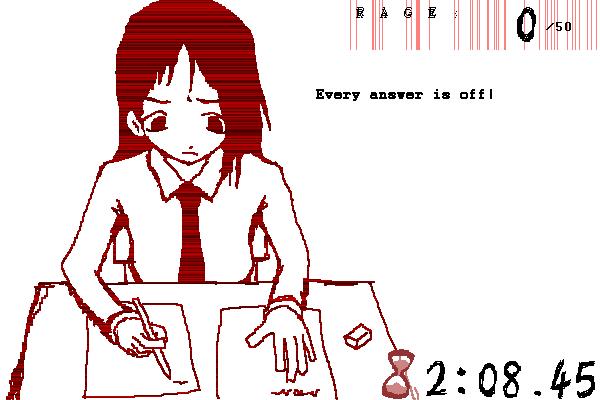
Despite having studied, not cheated, and done her best, Bakumi was en route to failing the test due to a technical mishap of her own making. Instead of rushing to fix her answers within the time limit, however, Bakumi logically concludes that the test makers, school, society, and the entire planet are corrupt and must be destroyed.
The game’s timer begins running as Bakumi is mulling over her test answers – before she catches her error (which she deems to be the fault of the test maker for not including a warning about misaligned answers). From that point, Bakumi has 3 minutes to build the rage to destroy the entire planet, sending everyone and everything hurdling off into space. The player, taking the role of Bakumi, must build up the rage to, in the words of Mr. Park at Insani, make Bakumi “the most powerful being in the universe.”
The official download page for Crimsoness includes the interactive visual novel’s most memorable quote:
… la la la la la SPLIT THE EARTH IN TWO la la la la la …
That more or less sums up Crimsoness.
Crimsoness Review
Many of my visual novel reviews focus on story and writing. There is little story and writing in Crimsoness. There are, however, many interactive mechanics – which promise to make this as unique a review as Crimsoness is unique in the al|together set.
Estimated reading time
Crimsoness has a 3-minute time limit, although it is possible to break the timer with a certain series of actions. But for all intents and purposes, the timer is legitimate, so a single play-through of Crimsoness should max at about three minutes. Failure will lead to the game ending before the expiration of three minutes. While there are enough ways to trip up before destroying the planet that I doubt most people will win (or lose?) Crimsoness on a first attempt, it should not take too many tries to reach the true, Earth-splitting ending.
Game-play and structure
A three-minute timer starts at the very beginning of Crimsoness while Bakumi is still taking her exam, before she realizes that she has made a serious mistake. The reader must left click to advance the text. Holding down on the left mouse button causes the text to proceed automatically. Regardless of how fast the person reads, the timer runs. Thus, advancing the text has no effect on the inexorable movement of the timer.
Once Bakumi sets out to destroy the world, Crimsoness introduces a “Rage Gauge.” The rage gauge increases with time and with specific actions. You can see it in the top right of the screen in the below screenshot.
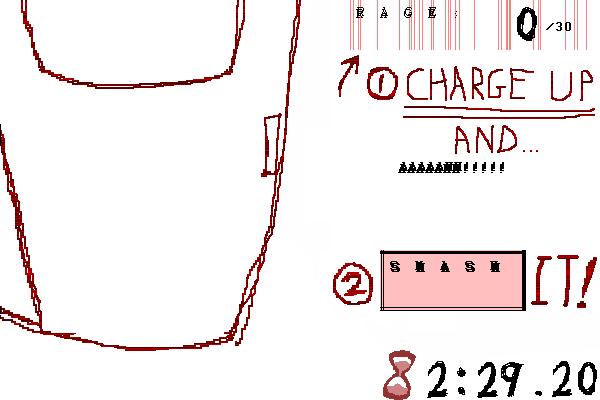

Clicking the rage gauge, or holding it down, charges it. There are certain thresholds needed to escape certain situations. This is the first event – where Bakumi must smash the door of her classroom to leave the test (why not just open it?), so the threshold here is low.

The requisite “rage” required for different scenarios varies, and not knowing what awaits in each location that Bakumi visits is why it is unlikely (albeit not impossible) to reach the end on a first try. You can see the room-select screen below.
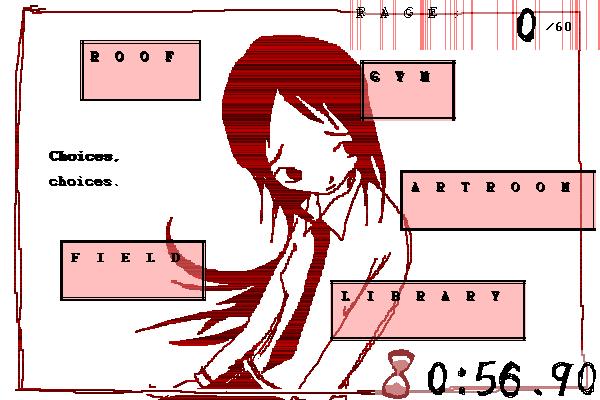
It should suffice to say that if you happen to stumble upon a croc, you may need a good amount of rage.
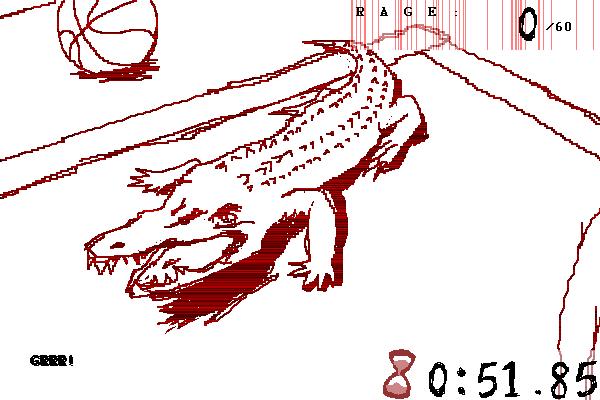
Other events have low rage thresholds, allowing Bakumi to build rage for tougher events.
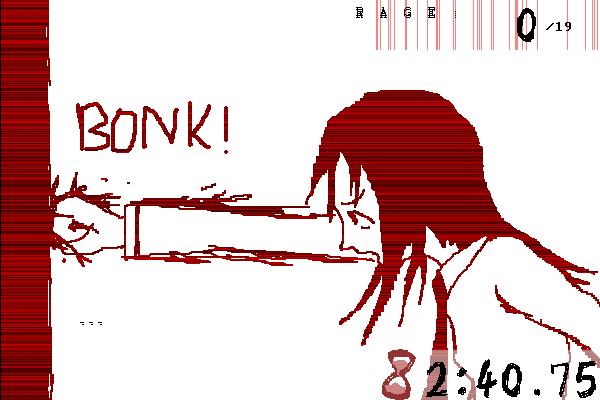
The game ends at the expiration of three minutes – however, Bakumi may have an opportunity to subvert the paradigm (people who read will get the reference) and smash the 3-minute hourglass if she has enough stored up rage.
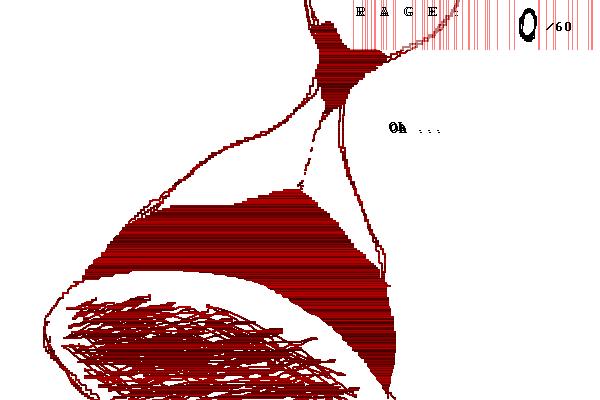
If Bakumi can build up enough rage within 3 minutes and avoid fates such as being distracted by people trying to sidetrack her from destroying the entire planet or being eaten by large carnivorous lizards roaming the school, she can put her rage to the worthy goal of splitting the entire planet in two.
(Note: There is at least one instance when you need rage in moderation, but I will leave that for readers to discover on their own.)
Visuals
Crimsoness has a unique visual style. The novel looks like it was drawn in Microsoft Paint or a similar raster editor, and it has a distinct red hue. As I noted before – the choice of red works well in light of the fact that Bakumi’s planet-destroying ambitions were prompted by the prospect of seeing red on her test due to her own technical mishap. However, the Japanese name for the game seems to translate to something to the effect Burning Princess – so red also aligns with Bakumi’s irrational rage about the unfairness of the universe allegedly causing her to make a silly mistake on a school exam.

There are no character sprites in Crimsoness of the sort we have seen in many of the al|together translations. Each scene is fully drawn, and the character dialogue appears on a section of the scene where it is not obscured by a character or background. A good number of scenes and drawings went into Crimsoness, ensuring that there are no repeats in any room or location Bakumi ventures into.

One interesting visual point is that some of the text in Crimsoness – namely dramatic comic book-style sound effects – is actually drawn into the background. Because the original game was entirely in Japanese, you can imagine how this caused some complications for the translators. The principal translator, Mr. Edward Keyes, explained how Insani handled this text (note that Seung refers to the supervising translator, Mr. Seung Park):
Seung initially modified a few of the screens which contained hand-drawn text, since it was easiest to just edit the graphics directly while translating their contents. For the sound-effect graphics, more elaborate work was needed. … Eschewing the traditional tools such as Photoshop, I bravely grabbed a pencil and drew out all of the sound effects on paper, in my best and roughest comic-book style. As you can tell from the result, I am no artist, and this was my greatest advantage, because of the feel of the rest of the game. They’re supposed to look exactly like that! Really!!
Edward Keyes
I suppose you know you have an interesting translation project when you have to moonlight as a visual novel artist. In any event – I never thought anything of the English text written into some scenes.

That is a credit to Mr. Keyes and Mr. Park for ensuring that the English text they drew into the game fit in naturally with the overall art style.
On the whole, Crimsoness has one of the most memorable visual designs of al|together, likely rivaled only by Until We Meet Again from al|together 2005. While opinions may vary, I think the visual aesthetic fits the absurd content of the game very well.
Music
Crimsoness has a single soundtrack – it is slow and a bit ominous. In light of the fact the game generally takes about three minutes at its longest, sound track repetition is not a pressing concern here. The background music suits Crimsoness but it does not stand out in the same way as the visuals or Bakumi’s only semi-coherent rage. More notable than the music is the game’s sound effects for Bakumi going SMASH. This is very important for giving the player some sense of satisfaction for, say, breaking down a door or engaging in combat with a large reptile.
Translation quality
Mr. Seung Park, who supervised Mr. Edward Keyes’ translation of Crimsoness, explained, somewhat humorously, that the original Japanese script for Shakunetsu Hime was not the most difficult part of the localization project:
The script of this piece is simple and monosyllabic — as you can see for yourself, a good deal of it is spent in incoherent screaming, wet thudding sounds, and occasional large carnivorous reptiles being sent into the stratosphere, in roughly that order. The entire piece is otherwise written at about a fifth or sixth grade comprehension level, and as such the resultant translation was nice, competent, and done in a very small amount of time.
Seung Park
Solely from the perspective of an English reader – I concur that “the resultant translation was nice [and] competent.” I had no issues following Bakumi’s ranting against the universe or her incoherent screaming. The other characters, including carnivorous reptiles, read well in English.
Mr. Park’s peer review offered some interesting insights into how he and Mr. Keyes handled the rage gauge translations – since the length of the direct translations of the original Japanese terms to describe the rage gauge levels meant they would not have fit on the gauge. Mr. Keyes’ translation essay went into details on technical formatting issues he had in light of the design and coding of the original Japanese game (see note in visuals review section).
Mr. Park explained in a separate essay how he and Mr. Keyes worked to gain the developer, Porn’s, permission to translate the game:
During our negotiations, Porn and I had a long conversation about the nature of novel game localization, and about the differences I see between the interactive fiction of the West and the uniquely Japanese novel game genres. We were granted the rights to officially translate his piece into English, but only after we showed him definitive proof that our localization was both accurate and stylistically correct.
Seung Park
I dare say Porn, or Pawn, made the right call in giving his blessing to Insani to translate his work.
Writing and story quality
Crimsoness is a game wherein an enraged schoolgirl sets out to destroy the world because she messed up on her test. Is there a deeper meaning? Mr. Park, based on having worked to translate the game and discussed the work with the original creator, answered in the negative. He offered his analysis essay after applying various sorts of critical theory readings to the game’s absurd script:
Crimsoness is an enjoyable novel game, and one that is designed to provoke laughter, not the unthinking rage that the protagonist of the piece demonstrates so well. From conversations with the author of the piece, I know very well that he had no intention of broaching any of these topics — indeed, he would roll his eyes at anyone who seriously read Crimsoness in an analytic manner. And at the end of this exercise, so would I.
Seung Park
I agree with Mr. Park’s emphasis on understanding the intent and purpose of the creator of a work to understand the work. I wrote something similar in my first al|together review, The Poor Little Bird (also translated by Mr. Edward Keyes under the supervision of Mr. Park). There, I prefaced my interpretation of the story by explaining that I would first try to understand the meaning and intention of the author, there being Mr. Eno Yamamoto Ten, before offering my subjective analysis of his script and message. I embarked on the same enterprise in my analysis of later al|together reviews From the Bottom of the Heart and Shooting Star Hill. The correct way to meaningfully analyze stories is to first understand what the author wrote before engaging with the views of the author and his or her characters and offering your own opinion of the merits of the author’s writing and perspective.

When I first read Crimsoness in 2010 or 2011, before even having read Mr. Park’s analysis, I reached a similar conclusion. If one had any inclination to take Crimsoness seriously or literally when Bakumi smashed the door of her classroom to enter the hallway (I would be impressed that they could still do so after Bakumi blamed political corruption for her test not coming with a warning to put the answers in the correct boxes), all doubt should be lifted around the time Bakumi has to pick a fight with a statue or stare down a crocodile.
Crimsoness is memorable because it is absurd, not because it has any deeper meaning. Suffice it to say, Crimsoness will not require the sort of in-depth analysis that I conducted for From the Bottom of the Heart and Shooting Star Hill, and that I plan to offer for a few other al|together games.
The stand-out point about Crimsoness is not its ridiculous script alone, but how that script works with the game’s two interactive mechanics – the time limit and the rage gauge. Of all of the al|together projects, it reminds me most of a a game I reviewed with a very different story and feel, 2006’s Summer, Cicadas, and the Girl. Cicadas did not stand out at all for its story – which was close to the same length as Crimsoness’s and very pedestrian – but for its mechanic, which required the player to guess the location of one of the game’s main characters by typing it out – with only the correct choice yielding the true ending. That mechanic alone and some other aspects of its implementation made Cicadas one of the stand-out al|together entries in my view, and solving the game’s little puzzle made the game’s happy true ending feel more satisfying than the text alone would suggest. Similarly, Crimsoness’s absurdity in its script is fully intertwined with its engaging mechanics. Reading about Bakumi fighting a crocodile, cutting short a meta lecture, or trying to destroy the planet would be far less engaging than figuring out and completing the correct sequence of steps to make these things and the end result possible.
Other material about Crimsoness
A few other interesting points about Crimsoness…
Winner of 3-minute game contest
Crimsoness won accolades in Japan before it was translated into English. It won the 12th 3-minute game contest back in 2007. While the site which gave it the honor, 3punge, is no longer online, I retrieved an April 9, 2007 Wayback Machine archived version of the page showing Crimsoness’s victory (Japanese). The link includes the other 11 articles which ranked in the contest.
TV Tropes page
TV Tropes is a popular website which lists tropes in movies, tv series, books, comics, and games. Someone thought enough of Crimsoness to add it to TV Tropes, and its list of tropes is surprisingly robust. Crimsoness is, to the best of my knowledge, the first al|together visual novel I have reviewed thus far with a TV Tropes entry, but Narcissu (which is a forthcoming review) is also on the site, as is Insani’s non-al|together translation project from 2008, True Remembrance.
Conclusion
Crimsoness is one of the small number of al|together games that I played well before (in this case about 10 years before) I started my review project in 2021. I remembered it well – even some of the specific details. Crimsoness is over the top to the point that, despite its short length, it has a way of sticking with you in your memory. It is the most interactive game of the entire al|together set, with its only rival in the area of interesting mechanics being Summer, Cicadas, and the Girl. Of the novels I have reviewed thus far – it has one of the most distinctive visual styles, putting it in a class with Until We Meet Again and Insant Death! Panda Samurai in terms of doing something different than the norm.
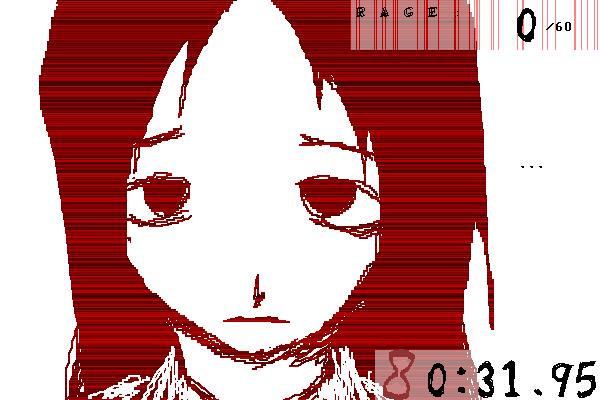
Despite my general praise for Crimsoness’s design and absurdity, I give it a qualified recommendation for general audiences. Some aspects of its humor will be hit or miss depending on the reader. But it is worth playing for people interested in visual novels and the al|together project for its over-the-top presentation and genuinely interesting game-play.